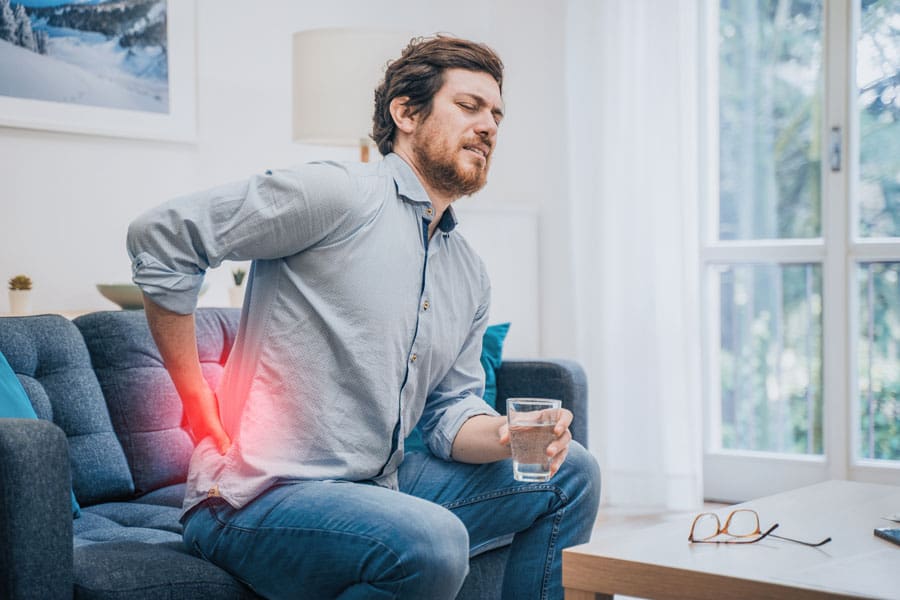Lumbago Disease
Lumbago is a condition when the functionality of the back muscles becomes limited, especially in the area of the lumbar spine. This usually happens with daily body movements like getting up from a seated posture, bending, or lifting. In other words, lumbago is the body’s natural way of self-defense; it is the body’s reflex response when back muscles are tensed. This response protects nerve fibers and the spin from any kind of injury. The increased muscle tension causes pain, restricted movement, and other usual symptoms.
Additionally, this condition brings an increased level of sensitivity in the lumbar spine area. Because of this, lumbago is often termed as non-specific back pain. Most often, 80% of chronic and acute back pain cases are lumbago disease. As mentioned, it is non-specific due to the fact that the cause of this pain is unknown to date, as the usual diagnostic methods don’t reveal fascial adhesions, muscle tightness, and myofascial imbalances.
Signs & Symptoms of Lumbago
The most common symptom of lumbago disease is severe and sudden pain in the lower back. This pain usually spreads out, and each patient may describe or experience it differently. But irrespective of the severity of the pain, it becomes difficult to move around in the usual way or stand upright. This is due to the critical tightness of the back muscles and overworking of the fascia when a person is standing upright, which sends pain signals to the brain.
This back pain usually mellows down in a couple of days. Some other symptoms of lumbago disease are:
- Pain in the lumbar region of the spine is the main symptom of lumbago disease. This pain involves muscle tension, stiffness in the lower back, and achiness. In rare cases, it can impact normal mobility.
- Localized pain, confined to a smaller area
- Restricted spinal movement during bending over or leaning backward
- Pain in the lower back region that may spread out into the back of the thigh, buttock, or groin
- Feeling of numbness along with tingling sensation in the back, buttocks, or leg, which spreads to the foot
- Inflammation of the leg or back
- Lower back pain during coughing or sneezing
Causes & Risk Factors Associated with Lumbago
Sometimes, it is difficult to pinpoint the cause of lumbago even after complete medical sets. Several factors can cause this disease, but the key reason is the sudden lifting of a load and overuse of the lower back. Repetitive movements involving the lower back and excessive bending can also cause lumbago. Other factors include spinal arthritis, osteoarthritis, herniated or slipped disc, spinal stenosis, spinal tumors, or scoliosis.
- Frequent sitting with a bent forward direction:
Sitting bent forward for a longer duration can create a biomechanical imbalance between the spine and pelvis. In severe imbalance cases, the body responds in the form of lumbago.
- Muscular weakness:
Weak core muscles cannot maintain myofascial balance, and if there is a jerky movement, the back muscle tense as a reaction to protect the spine.
Some risk factors that may increase the chances of lumbago disease in individuals are:
- Age
- Lack of exercise
- Obesity
- Inaccurate lifting technique
- Smoking
- Other physiological problems
Treatment of Lumbago
Treatment for lumbago disease depends on various factors, including patient weight, age, and daily activity level. A mix of the following treatment options can be considered to treat lumbago:
- Rest during severe pain: During severe pain, it is essential to give the body rest. Relieving pressure off the lower back muscles by limiting body movements can alleviate these symptoms.
- Heat packs or cold compresses: Utilizing a heat patch/hot water bottle or cold compression can also relieve the lower back pain of lumbago.
- Exercises for muscle lengthening: After reducing the muscle tension, different muscle length exercises can be done to increase the mobility of the specific area. These exercises relax and reorient the fascial structures for better and painless mobility.
- Muscle strengthening: Inactive and weak muscles tend to become tense. With strength exercises, these muscles can be brought back into their original condition, thus restoring the balance of tensioning structures.
- Lifestyle change and non-specific movements: Certain lifestyle changes, behavioral modification, and non-specific movements are some of the day-to-day techniques that can do wonders for lumbago disease. Activities like a daily walk, stretching exercises, and moderate physical activity can help relieve symptoms of this condition.
Although lumbago can be self-treated if the symptoms persist even after regular exercises and other treatments, it is better to consult Dr. Przybysz as it is vital to detect the underlying cause of the problem.
Get lasting relief for pain from Lumbago?
Being diagnosed with lumbago or any neurologic disorder is life-changing. Seeking our professional help to get over these health issues is the best first step. We’ll work with you and your other healthcare providers to ensure a proper diagnosis and create a customized treatment plan that is right for you.
Call us or book an appointment online, and begin reclaiming your life with less pain.
Online Appointment Scheduling
Schedule an appointment with Monarch Pain Management via our scheduling partner at growpractice.net. You can reschedule and cancel, as well.

Reclaim Your Mobility
Make an
Appointment


